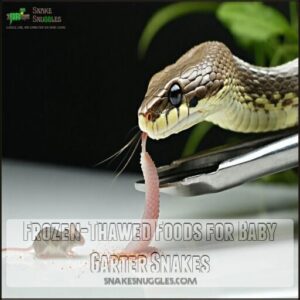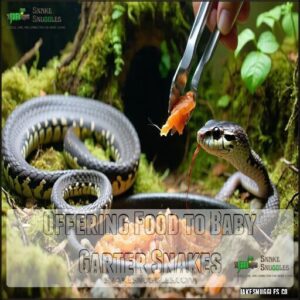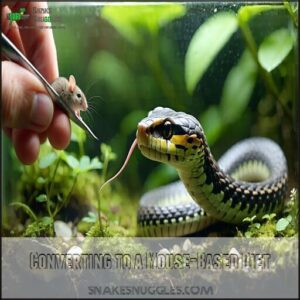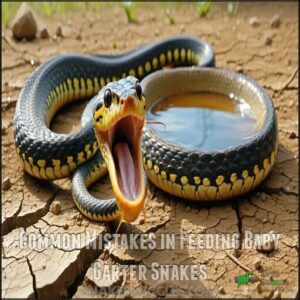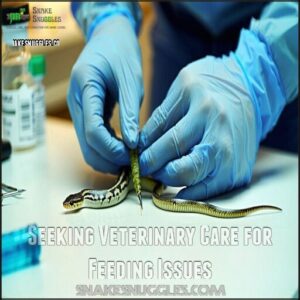This site is supported by our readers. We may earn a commission, at no cost to you, if you purchase through links.
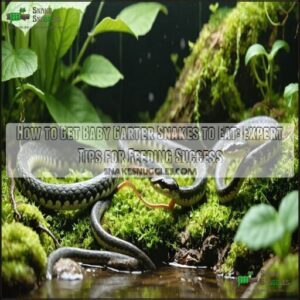 Getting baby garter snakes to eat starts with offering the right food in a calm environment. Earthworms, cut into small pieces, or live feeder fish often work best because these mimic their natural diet.
Getting baby garter snakes to eat starts with offering the right food in a calm environment. Earthworms, cut into small pieces, or live feeder fish often work best because these mimic their natural diet.
Make sure the enclosure is warm enough (around 75-85°F) since snakes won’t eat if they’re too cold. Try feeding in the evening when they’re naturally more active.
If they still won’t eat, scenting food with fish or wiggling it gently can trigger interest. Patience is key—some babies take time to adjust.
Keep offering food every few days, and monitor their weight to confirm they stay healthy.
Table Of Contents
- Key Takeaways
- Why Won’t My Baby Garter Snake Eat?
- Choosing The Right Food for Baby Garter Snakes
- Feeding Baby Garter Snakes for The First Time
- How Often to Feed Baby Garter Snakes
- What to Feed Baby Garter Snakes
- Problem Feeders: What to Do
- Converting to a Mouse-Based Diet
- How Long Can a Garter Snake Go Without Food?
- Common Mistakes in Feeding Baby Garter Snakes
- Seeking Veterinary Care for Feeding Issues
- Frequently Asked Questions (FAQs)
- What do baby garter snakes eat first?
- What is the diet of garter snakes?
- What should you avoid feeding to baby garter snakes?
- How to encourage a fussy baby garter snake to eat?
- Do Baby garter snakes eat earthworms?
- How to feed a baby snake that won’t eat?
- Can you keep a wild baby garter snake?
- How do you encourage garter snakes?
- How often should you feed a baby garter snake?
- What do garter snakes eat?
- Conclusion
Key Takeaways
- Keep the enclosure at 75–85°F with proper humidity and minimal stress to encourage natural feeding behavior.
- Start with appropriate prey like chopped earthworms or small fish, and always match the food size to the snake’s thickest body part.
- Use scenting techniques like rubbing fish juice on prey or mimicking live movement with feeding tongs to spark interest.
- If the snake still won’t eat, avoid force-feeding and consult a reptile-savvy vet to rule out health issues or adjust care strategies.
Why Won’t My Baby Garter Snake Eat?
If your baby garter snake isn’t eating, it might be stressed, sick, or adjusting to its new environment.
Identifying the reasons behind their appetite loss is essential for ensuring their health and proper growth.
Common Reasons for Reduced Appetite
When your baby garter snake won’t eat, understanding the causes can help ease feeding problems.
Stress is a common culprit, often caused by frequent handling, loud noises, or poor tank setup. A cold environment slows metabolism, leaving your snake uninterested in food.
Frequent handling or cold tank setups can stress your baby garter snake, slowing its metabolism and reducing its appetite.
Shedding cycles add another layer—watch for dull skin or cloudy eyes, both signs your snake is preparing to shed. Health issues, like parasitic infections or even a thiamine deficiency from certain foods, might also reduce appetite. A key indicator can be snake diseases like respiratory issues.
Here’s what to check:
- Environmental stress: Is the tank calm and properly set up?
- Temperature levels: Is the basking area warm enough?
- Shedding cycle: Do they show pre-shed signs?
- Illness symptoms: Lethargy or unusual behavior?
- Diet quality: Are you feeding suitable prey?
Environmental Factors Affecting Appetite
Your garter snake’s feeding troubles might stem from its environment. Start by ensuring temperature regulation—maintain a gradient of 72–82°F with a basking area at 90–95°F using a heat lamp.
Keep humidity levels between 35–60% and establish a consistent lighting schedule to mimic natural day-night cycles.
Use an enclosure size of at least 36"x18"x18" with plenty of hiding spots for thermoregulation and stress reduction. Fresh, clean water and proper water quality are non-negotiable.
A cozy, well-ventilated snake feeding environment with live plants can create a more natural habitat, helping your snake feel secure and boosting its appetite.
Abnormal Reasons for Reduced Appetite
Not eating could point to health problems.
Keep an eye out for signs like visible weight loss, inactivity, or frequent regurgitation.
Some culprits include:
- Metabolic Disease: With improper temperatures, digestion slows, causing feeding problems.
- Parasitic Infections: Worms or mites disrupt digestion, leaving your snake stressed.
- Thiamine Deficiency: Fish-heavy diets can cause this, leading to lethargy.
Stress reduction and proper care prevent these issues.
Persistent symptoms? Consult a reptile-savvy vet!
Home Care and Support for Non-Eating Snakes
If your snake won’t eat, minor tweaks can solve feeding problems.
Minor adjustments to the environment or feeding techniques can often resolve your snake’s appetite issues and encourage healthier mealtime habits.
Try hydration strategies, like warm, shallow baths, or adjust the tank’s temperature to 75-85°F with 40-60% humidity.
Stress reduction is key; limit handling and provide enrichment options like hiding spots.
Scent food with fish juice or wiggle prey to mimic movement, encouraging natural feeding instincts.
Assist feeding is a last resort, and force-feeding should only happen under veterinary consultation.
Patience and a proper environment usually resolve snake feeding problems effectively, using stress reduction techniques.
Choosing The Right Food for Baby Garter Snakes
Feeding baby garter snakes starts with selecting the right food that matches their natural diet and nutritional needs.
From earthworms to small fish, choosing appropriately sized prey guarantees they can eat comfortably and grow healthily.
Live Foods for Baby Garter Snakes
Live prey is a fantastic way to spark a young garter snake’s natural hunting instincts. Observing movement in their food can make feeding more successful.
Here’s how you can provide live food safely:
- Earthworms: Fresh, wriggling worms are irresistible. Make certain they’re farm-raised and properly sized; cut larger ones to fit.
- Fish: Use guppies or minnows. Their swimming motion encourages feeding. Prioritize guppy safety by sourcing from parasite-free suppliers. Consider guppies as live food for your snakes.
- Insects: Offer crickets or grasshoppers bred for reptiles. Sourcing insects from trusted vendors prevents contamination.
- Other Prey: Frogs or snails can supplement meals. Use frog alternatives and prepare snails carefully, removing harmful debris.
Frozen-Thawed Foods for Baby Garter Snakes
Frozen-thawed foods are a fantastic option for baby garter snake feeding, offering convenience while reducing risks like parasites.
Start by safely defrosting small snake food such as pinky mice or fish. The best thawing methods include placing the food in the fridge overnight or submerging it in cool water for 30 minutes.
Once thawed, warm the food slightly—never use a microwave, as it can ruin its nutritional value. Consider purchasing frozen reptile feeders for ideal convenience. Use tongs to mimic live prey movement, especially if your snake shows hesitation.
Scenting techniques, like rubbing fish juice on pinky mice, can make frozen-thawed items more alluring. Remember, size matters—ensure the food doesn’t exceed the snake’s thickest body part.
Store frozen foods in sealed bags to maintain freshness. For extra nutritional value, lightly dust thawed items with reptile-safe supplements like calcium or multivitamins to support healthy growth.
Commercial Diets for Baby Garter Snakes
Commercial diets can be a convenient addition to your baby garter snake’s feeding plan, but they shouldn’t replace natural food options entirely.
While prepared formulas and pellet food offer ease, they lack the diversity found in live or frozen prey, which is essential for a healthy garter snake diet.
Here’s how to include commercial diets safely and effectively:
- Choose reputable brands with a proven track record in reptile diets.
- Pair small snake food, like earthworms or fish fillets, with purchased formulas to guarantee balance.
- Monitor costs and effectiveness by observing your snake’s appetite and health over time.
- Transition gradually, using scenting if needed to encourage acceptance.
- Avoid reliance by maintaining variety, reducing the risk of nutritional gaps.
A well-rounded diet keeps your garter snake active and thriving.
Supplements for Baby Garter Snakes
Supplements play a big role in guaranteeing your baby garter snake gets a balanced diet. Start by dusting prey with calcium supplements 2-3 times a week. For proper absorption, pair this with Vitamin D3 powder, following package instructions carefully.
Multivitamins are another smart addition, used 1-2 times weekly to cover nutritional gaps. Worried about feeding fish? Keep thiamine concerns in mind since some fish contain thiaminase. Add Vitamin B1 or cut back on fish-based meals to avoid deficiencies.
Use gut-loaded insects for a natural boost, ensuring prey is stuffed with nutrients beforehand. Remember that trace minerals are essential for immune function and metabolism. Stick to a supplement schedule—overdoing it can harm your snake.
Thoughtful supplementation guarantees your baby garter snake grows healthy and thrives!
Feeding Baby Garter Snakes for The First Time
Feeding a baby garter snake for the first time requires patience and careful preparation to guarantee a positive experience.
Start with small, easy-to-eat prey like sliced earthworms or finely chopped fish, and make sure the food is appropriately sized for your snake, which is a key factor in ensuring a positive experience.
Preparing The Snake for Its First Meal
Getting your baby garter snake ready for its first meal starts with creating a calm and stress-free environment.
Proper tank acclimation helps with newborn snake care and appetite.
Maintain a temperature gradient of 75–85°F, with a warm basking spot.
Stress reduction is easier with plenty of hiding spots and clean water availability nearby.
Use damp sphagnum moss to boost humidity, especially if shedding signs appear.
Avoid handling for at least 24 hours before feeding.
A relaxed baby garter snake in an ideal setup is more likely to eat without hesitation, and this is crucial for newborn snake care and ensuring a stress-free environment for feeding.
Offering Food to Baby Garter Snakes
Feeding a baby garter snake for the first time can feel tricky, but understanding Prey Size and Food Presentation makes a big difference. Start with small, soft foods like chopped earthworms, brine shrimp, or bloodworms. Place the food on a shallow, stable Feeding Dish or near a hideout to encourage timid snakes.
If your snake won’t eat, experiment with Scenting Techniques, like rubbing fish fillet juice on pinky parts to mimic prey. Try these methods to spark their interest:
- Wiggle food using tongs to mimic live prey and trigger instincts.
- Warm thawed food slightly to make it smell fresh.
- Use live prey like feeder guppies for picky eaters.
- Leave food overnight to allow shy snakes to eat in peace.
Stay patient. With time, your snake’s Feeding Success will contribute to their growth and health!
Hand-Feeding Baby Garter Snakes
Handfeeding young snakes can feel like an art, but with the Tongs Technique and plenty of patience, you’ll get it down.
Gently offer thawed pinkies or small worm pieces using tongs, wiggling the food for lifelike movement.
Watch for Refusal Signs and adjust your Food Presentation if needed—some snakes respond better to Scenting Strategies like rubbing prey with fish juice.
Using specialized feeding equipment can also improve safety.
Handfeeding guarantees proper snake feeding and helps your baby garter snake start eating with confidence.
Tips for Feeding Baby Garter Snakes
Baby garter snakes can be picky eaters, but a few effective techniques make feeding easier.
Start by choosing the right food size—prey shouldn’t be bigger than the snake’s thickest body part. Use tongs to offer small, manageable items like pinky parts, chopped worms, or thawed fish.
Stimulate their hunting instincts by mimicking live prey movements. Wiggle the food gently to catch their attention.
If they refuse, try these snake feeding tips:
- Use live prey like garden worms or feeder guppies to spark interest.
- Warm food slightly to enhance its scent and appeal.
- Scenting techniques, such as rubbing fish juice on pinkies, can encourage eating.
- Serve meals in a shallow dish to prevent substrate ingestion.
- Provide baby garter snakes with variety, rotating food types.
Patience guarantees successful garter snake feeding!
How Often to Feed Baby Garter Snakes
Feeding baby garter snakes every other day guarantees they get the nutrients needed for growth and energy.
Adjust the schedule as they grow, keeping a close eye on their size and appetite.
Feeding Schedule for Baby Garter Snakes
A consistent feeding schedule is vital for baby garter snakes to thrive.
Offer meals every 2–3 days, making certain the meal size matches your snake’s body width to prevent regurgitation.
Regular feeding times create predictability, supporting healthy digestion and growth.
As your garter snake grows, adjust the frequency to match appetite and body changes — this is called Frequency Adjustments.
Include hydration schedules alongside feeding, as small snakes quickly dehydrate.
Seasonal variations, especially temperature changes, may also influence snake feeding patterns.
Monitoring growth guarantees proper meal size and steady development for ideal snake health, ensuring healthy digestion and steady development, and supporting overall snake health through proper meal size.
Factors Affecting Feeding Frequency
Age and size, metabolism rate, and activity level all influence garter snake feeding frequency.
Younger snakes burn calories faster, demanding smaller, regular meals. Metabolism speeds up in warm enclosures but slows in cooler setups, altering how often they’ll eat.
Because baby garter snakes molt frequently, their shedding cycle can briefly suppress appetite. Stress, such as new habitats or noisy environments, can also create feeding challenges.
- Tank temperature: Warmer environments boost digestion.
- Size and age: Growing snakes eat more than adults.
- Food type: Nutrient-rich meals last longer.
- Activity: Lively snakes need more energy intake.
Monitoring Growth and Adjusting Feeding Schedule
Keeping tabs on your baby garter snake’s growth rate is key to mastering their feeding schedule.
Start a growth log to track weight, length, shedding frequency, and each meal.
Regular weight tracking gives you clues about their health and feeding effectiveness.
Here’s a simple feeding guide:
| Age (Weeks) | Feeding Frequency | Food Size |
|---|---|---|
| 1-4 | Every 2-3 days | Pinhead-sized |
| 5-12 | Every 3-4 days | Pencil-thin |
| 13+ | Every 4-5 days | Finger-width |
Pay attention to their activity levels.
A snake exploring its enclosure and eating consistently likely has balanced nutrition.
If your snake looks too thin, adjust portions upward.
If it seems sluggish or bloated, reduce.
Monitor how growth aligns with feeding.
A healthy garter snake grows steadily, sheds regularly, and feels firm, not frail.
Your baby garter snake’s behavior is your best feeding schedule guide—watch and adapt!
What to Feed Baby Garter Snakes
Baby garter snakes thrive on a diet that mimics what they’d eat in the wild, such as earthworms, small fish, and pinky mice.
Choose prey that’s appropriately sized to prevent choking and guarantee proper nutrition for healthy growth.
Earthworms as a Food Source
Earthworms are a fantastic staple in a baby garter snake’s diet, offering high nutritional value and hydration in every bite.
For safe and effective feeding, here’s what you need to know:
- Worm Gut-Loading: Boost nutrition by feeding worms calcium-rich veggies like kale for 24 hours before offering them.
- Sourcing Earthworms: Always buy from trusted pet stores to avoid pesticides and parasites.
- Cutting Techniques: Slice larger worms into 1-inch pieces, as worm size matters for safe swallowing.
- Feeding Tips: Use tongs to mimic live movement, stimulating your garter snake’s natural feeding preferences.
Freshly rinsed, nutritious earthworms make feeding your garter snake simple, healthy, and satisfying!
Fish as a Food Source
Fish adds variety to a baby garter snake diet and stimulates their natural feeding instincts.
Stick to safe options like guppies, platies, or tilapia while avoiding goldfish due to thiaminase concerns, which can cause vitamin B1 deficiencies.
Feed fish as about 60% of their meals for a balanced garter snake feeding plan.
If using frozen fish, make certain of proper fish preparation by thawing and warming fish pieces slightly before offering.
Live guppies are excellent for encouraging hunting behavior and engaging baby garter snakes.
For picky eaters, scenting techniques like rubbing fish on other food make meals more appealing.
A varied diet will help guarantee sufficient nutrient intake.
Here’s a quick guide:
| Fish Type | Safe for Snakes? | Benefits | Feeding Method |
|---|---|---|---|
| Guppies | Yes | Encourages hunting | Offer live |
| Platies | Yes | High nutrition | Offer live or fresh |
| Tilapia | Yes | Vitamin-rich | Use warmed pieces |
| Goldfish | No | Thiaminase concerns | Avoid |
Mice as a Food Source
Mice, particularly pinky mice, are a nutrient-packed option for baby garter snakes.
These newborn, hairless mice are easy to digest and support healthy growth.
Start with small, manageable pieces that match your snake’s mid-body width to avoid choking.
Preparing frozen mice correctly is key:
- Thaw frozen pinky mice in warm (not hot) water for 15-20 minutes.
- Never use a microwave for thawing.
- If your snake is hesitant, scent them with fish juice to entice eating.
Use feeding tongs and mimic live prey movement to stimulate natural feeding instincts.
Tease-feeding works well with pinky pieces.
With patience and carefully selected food size, pinky mice can become a staple in your snake’s diet over time.
Other Food Options for Baby Garter Snakes
Adding variety to your baby garter snake’s diet can keep feeding time more exciting and nutritionally balanced.
Here are four great options to explore:
- Insects: Offer live crickets or small grasshoppers, ensuring they’re gut-loaded for maximum nutrition.
- Snails: Use snail meat or small soft-bodied snails, as their shells are manageable for baby garter snakes.
- Small Frogs: Occasionally, provide tiny frogs for variety, mimicking the wild garter snake diet.
- Earthworms: Fresh, chopped worms provide moisture and protein but should be served in a shallow food dish to prevent substrate ingestion.
Ensure food size matches your snake’s body width for safe consumption.
Problem Feeders: What to Do
When your baby garter snake refuses to eat, it’s important to identify the cause and adjust your approach.
Simple strategies, like scenting food or mimicking prey movement, can often resolve feeding issues effectively.
Identifying Problem Feeders
Spotting problem feeders in baby garter snakes starts with observing their behavior. If your snake won’t eat, watch for stress indicators like hiding, striking, or ignoring prey entirely. Take note of refusal patterns, such as sniffing food without striking or turning away.
Consistency is key—track weight monitoring regularly. Even subtle weight loss signals trouble. Keep an eye on hydration levels, as dehydration can reduce appetite. Record prey preferences carefully; some snakes avoid certain foods but accept others.
Unusual lethargy or aggression during feeding attempts can also signal problems. By identifying these snake feeding challenges and solutions early, you’ll know when intervention strategies are needed to support your baby garter snake’s health. Stress indicators and refusal patterns are crucial to recognize, as they can indicate deeper issues, and addressing them promptly is vital for the snake’s well-being, which relies on weight monitoring.
Strategies for Encouraging Eating
Struggling to feed a baby garter snake? Don’t worry—it’s common. A few well-tested feeding techniques can turn things around when your snake won’t eat.
Start by focusing on scenting techniques. Rub fish juice onto small pinky parts or chopped worms to mimic natural prey odors. This often triggers a feeding response.
Mimicking movement is another trick. Use tongs to wiggle food, creating life-like motion. This engages a garter snake’s hunting instincts.
Lastly, try overnight feeding. Place warmed, bite-sized food in the enclosure before bed. Shy snakes often eat when it’s quiet. Make certain the tank is stress-free with individual feeding, proper temperatures (75–80°F), and hiding options.
Experimenting with these snake feeding strategies can make all the difference in your garter snake’s success at mealtime!
Hand-Feeding Problem Feeders
Hand-feeding baby garter snakes requires patience and strategic techniques.
When your snake won’t eat, try these steps to encourage feeding:
- Tongs Movement: Use soft-tipped tongs to wiggle the food, mimicking live prey and triggering natural hunting instincts.
- Scenting Techniques: Dip food in fish juice to entice picky eaters, appealing to their sense of smell.
- Food Presentation: Place small, manageable food pieces on a flat surface near the snake to simplify access and encourage exploration.
These steps, combined with persistence and gradual introduction of new foods, can effectively transform tease-feeding into a successful process for problem feeders.
Seeking Veterinary Care for Problem Feeders
If your snake won’t eat despite trying everything, a veterinary consultation is vital.
A reptile-savvy vet can identify hidden issues affecting appetite, like parasites, respiratory infections, or environmental stress.
During your vet visit, prepare by sharing details like tank temperatures, diet, recent behavior, and any feeding attempts.
The vet may use diagnostic tests to check for health problems and recommend treatment options such as deworming, antibiotics, or adjustments to care routines.
Forcefeeding is risky without guidance, so follow your vet’s advice for feeding troubleshooting.
Follow-up care guarantees your garter snake regains its appetite and stays healthy.
With early intervention and preventative measures, you’ll help your baby snake thrive and avoid worsening feeding issues, ensuring a healthy and happy snake, and this requires veterinary consultation and proper care routines to prevent issues like respiratory infections.
Converting to a Mouse-Based Diet
Switching baby garter snakes to a mouse-based diet can provide them with the complete nutrition they need for healthy growth.
Start by offering small, defrosted pinky parts and use scenting techniques to make them more appealing.
Benefits of a Mouse-Based Diet
Switching your baby garter snake to a mouse-based diet offers several advantages that support their health and growth.
Mice, especially pinky mice, provide complete nutrition, supplying all the protein, calcium, and vitamins your snake needs in one meal.
Here’s why this diet works well:
- Complete Nutrition: Pinky mice are nutrient-dense compared to fish or worms.
- Improved Growth Rate: A mouse-based diet supports steady development.
- Cost Analysis: Frozen mice are affordable and store well long-term.
- Easy Switch: Pinky mice simplify feeding while promoting long-term health.
Introducing Mouse Parts to Baby Garter Snakes
Introducing mouse parts to baby garter snakes can provide a well-rounded, nutritious diet. Gradually offering pinky mice is a practical first step, as these are rich in essential nutrients. Always start with appropriately sized portions—size matters!
Here’s a quick guide:
| Age Range (Weeks) | Portion Size | Weekly Servings |
|---|---|---|
| 2-3 | 1/8 inch | 1-2 pieces |
| 4-6 | 1/4 inch | 2-3 pieces |
| 8-10 | 1/2 inch | 3-4 pieces |
Scenting techniques help encourage picky eaters. Dip mouse parts in fish juice or use feeding tongs to wiggle pieces, mimicking live prey movement—a trick called tease-feeding. Overcoming refusal might take patience, but persistence pays off.
A mouse-based diet supports healthy growth and guarantees nutritional completeness over time. Start small and progress confidently!
Tips for a Successful Transition
Keeping your baby garter snake interested in mouse parts can be tricky, but persistence works wonders.
Start by using scenting techniques—coat small pinky pieces with fish juice to make the food more appealing. Place these pieces near your snake’s basking area or hideout to create a calm feeding setting.
Use tongs to subtly wiggle the food, mimicking live prey movements. This stimulates natural hunting instincts.
Offer food every 3-4 days and keep a close eye on their response. Consistent feeding helps you recognize patterns and adjust.
Here are 3 ways to encourage better feeding:
- Try a gradual introduction of diet changes instead of rushing.
- Add diet variety like chopped worms or scented pinkies.
- Stick to a healthy feeding frequency, keeping stress levels low.
Patience leads to success!
How Long Can a Garter Snake Go Without Food?
Understanding how long a baby garter snake can go without food helps you monitor its health and know when to act.
While they can survive short fasting periods, prolonged refusal to eat can lead to serious health risks.
Factors Affecting Fasting Tolerance
Fasting tolerance in baby garter snakes depends on factors like age, size, hydration levels, and stress.
Younger snakes with smaller fat reserves can’t fast like adults, meaning prolonged refusal to eat often signals a deeper issue.
Maintaining proper temperatures is critical; cold setups slow digestion and discourage eating.
Dehydration affects a snake’s appetite, so make certain fresh water is always available.
Stress from noisy or cramped environments makes things worse, leaving snakes uneasy about meals.
If your snake won’t eat, evaluate its body condition, adjust tank conditions, and create a calm, balanced habitat to support a healthy garter snake feeding routine, ensuring proper hydration levels.
Risks of Prolonged Fasting
Prolonged fasting poses serious risks for your baby garter snake, especially if it won’t eat.
Without proper feeding, their health can rapidly decline due to immune suppression and growth stunting caused by malnutrition.
Here are the dangers:
- Weight Loss: Lack of energy reserves weakens your snake quickly.
- Dehydration Risks: Fluids deplete faster than replenished, stressing organs.
- Organ Failure: Starvation leads to metabolic decline, harming core functions.
- Digestive Issues: Irregular feeding harms gut bacteria, making recovery harder.
Address these snake feeding challenges to guarantee your snake thrives.
Snakes can also experience organ shrinkage during starvation as a survival mechanism.
Monitoring Health During Fasting
When your baby garter snake won’t eat, monitoring its health is key to avoiding bigger issues.
Check for weight loss weekly, as sudden drops indicate trouble. Keep an eye on hydration levels—sunken eyes or dry skin signal dehydration.
Observe activity changes like lethargy, noting any unusual behavior. Watch the shedding cycle and waste for irregularities.
If stress signs appear or health worsens, consult a reptile vet promptly for snake feeding troubleshooting and overall reptile health.
Common Mistakes in Feeding Baby Garter Snakes
Feeding baby garter snakes can be challenging if you’re making common mistakes like offering prey that’s too large or neglecting proper hydration.
Ensuring the right food quality, variety, and environmental conditions is essential for healthy eating habits, which includes providing the correct hydration.
Overfeeding or Underfeeding
Balancing your snake’s meals is key to avoiding obesity risks or growth stunting.
Overfeeding can cause bloating and lethargy, while underfeeding impacts development.
Here’s how to keep feeding on track:
- Match prey to body size: The food shouldn’t be larger than your garter snake’s thickest body point.
- Follow a feeding chart: Offer a small, manageable meal every 2–3 days for healthy digestion.
- Spot nutritional imbalances: Thin snakes need larger portions; bloated ones need less.
- Track growth regularly: Use a scale to monitor weight, ensuring steady, proper development.
A well-balanced snake diet promotes ideal health and energy!
Inadequate Hydration
When your snake won’t eat, hydration is a common issue.
Low humidity or poor water quality stresses garter snakes, decreasing appetite.
Keep a shallow water dish in the tank, refreshed daily, and watch for normal drinking behavior.
Boost humidity to 40–60% with weekly misting to mimic their habitat.
Wrinkled skin or lethargy?
These are dehydration clues needing attention.
Soak your baby garter snake in lukewarm water for 10–15 minutes—this supports shedding and hydration, improving feeding chances.
| Problem | Observation | Solution | Outcome |
|---|---|---|---|
| Dehydration | Wrinkled skin | Soak in warm water | Improved hydration |
| Low water quality | Refusal to drink | Change water daily | Revives appetite |
| Inadequate humidity | Lethargy, dry skin | Mist enclosure frequently | Healthier snake |
| Shedding difficulties | Stuck skin patches | Provide humid hide | Smoother shed process |
Focus on hydration methods to tackle feeding struggles.
This approach can help address common issues like dehydration and low water quality, leading to a healthier snake.
Poor Food Quality or Variety
A garter snake’s diet demands variety to guarantee health and prevent picky eating. Feeding the same food repeatedly may lead to nutritional deficiencies or a snake that simply won’t eat.
Offer a mix of live, frozen-thawed, and fresh options to address these concerns.
- Rotate regularly: Include live earthworms, thawed pinky mouse pieces, or small fish.
- Beware of thiaminase: Avoid fish high in thiaminase, which can cause deficiencies.
- Proper food size: Matches the thickest part of your snake’s body.
- Thaw thoroughly: Use proper defrosting methods to bring food to room temperature.
Keep meals fresh, appropriately sized, and varied to maintain a balanced garter snake diet and encourage consistent feeding.
Inadequate Environmental Conditions
Is your baby garter snake skipping meals?
Check the snake tank setup—they thrive in stable environments.
Verify a temperature gradient of 75–85°F and humidity levels around 40–60%.
Provide a clean enclosure size suitable for exploration, with secure hiding spots and fresh water for proper water quality.
Proper snake environment supports digestion, reduces stress, and encourages snake feeding success.
Seeking Veterinary Care for Feeding Issues
If your baby garter snake refuses to eat despite your best efforts, it’s time to consult a reptile-savvy veterinarian.
They can assess your snake’s health, identify any underlying issues, and guide you on the next steps to encourage feeding.
When to Seek Veterinary Care
If your snake won’t eat, consistently refuses food, or shows weight loss, don’t ignore it.
Persistent refusal to eat, lethargy signs, or physical abnormalities—like swelling or bloating—could point to serious health concerns. Parasite concerns or digestive problems often require professional snake veterinary care.
Force-feeding is a temporary solution, not a fix. For expert reptile feeding advice, consult a reptile-savvy veterinarian promptly.
Early intervention protects your snake’s health, avoiding complications. Always monitor feeding issues closely, especially if paired with behavior changes or visible distress in your baby garter snake. Prevention is key to ensuring your snake remains healthy, and early intervention is crucial in addressing any potential issues.
Finding a Reptile-Savvy Veterinarian
If your garter snake won’t eat, finding a reptile-savvy veterinarian is critical.
A qualified vet with solid snake veterinary care and reptile experience can address feeding problems effectively. Start with the Association of Reptile and Amphibian Veterinarians (ARAV) directory or follow local referrals from pet stores or rescue groups.
Call clinics and ask about:
- Vet qualifications: Confirm they specialize in snake health.
- Emergency care: Confirm after-hours availability.
- Vet costs: Clarify consultation fees upfront.
This guarantees reliable support for your reptile feeding concerns.
Preparing for a Veterinary Visit
Preparing for a vet appointment guarantees effective care for your garter snake’s health.
Start by documenting your snake’s feeding history, environmental changes, and specific symptoms like weight loss or lethargy. Secure transport is critical—use a well-ventilated, escape-proof container and keep the temperature stable to avoid stress.
Bring a fresh fecal sample for testing, saving time during the visit.
- Checklist to Prepare:
- Feeding records (frequency, type, portion sizes)
- Photos or notes on unusual behaviors
- Details about enclosure setup and temperature
- Recent signs of parasitic infections or shedding issues
Preparation helps your reptile-savvy veterinarian identify potential health concerns accurately.
Following Veterinary Advice for Feeding Issues
After meeting with your reptile-savvy veterinarian, follow their instructions carefully to support your snake’s health.
Stick to any specialized diets, feeding schedules, or medication plans they’ve provided.
If diagnostic tests revealed issues, address those steps right away, like adjusting environmental temperatures.
Communication with your vet is key.
Update them if the snake won’t eat after a recommended solution or if behavior seems off.
Be consistent with medication administration if prescribed, and never skip follow-up care visits.
Keep detailed notes on your snake’s progress, from feeding attempts to shedding cycles.
This helps track improvements and informs future consultations.
Remember, veterinary care is about solving feeding problems now and setting a foundation for long-term well-being.
Careful attention guarantees your snake thrives.
Frequently Asked Questions (FAQs)
What do baby garter snakes eat first?
Did you know baby garter snakes can start eating just a day after birth?
Begin with finely chopped earthworms or small insects like crickets.
Make certain sizes stay manageable, about the thickness of their body’s widest part.
What is the diet of garter snakes?
They eat earthworms, insects, small fish, amphibians, and newborn mice.
Earthworms are a favorite, packed with protein and moisture.
Fish should be thiaminase-free, while pinkies offer complete nutrients.
Always match prey size to their body.
What should you avoid feeding to baby garter snakes?
Don’t feed baby garter snakes large prey, live rodents, or fish with thiaminase, like goldfish.
Avoid hard-shelled insects, processed human food, or spoiled meat.
These can harm digestion, cause deficiencies, or pose choking hazards.
How to encourage a fussy baby garter snake to eat?
Getting a fussy baby garter snake to eat can feel like convincing a toddler to broccoli.
Try scenting food with fish juice, using tongs to mimic movement, or offering live earthworms to spark interest.
Do Baby garter snakes eat earthworms?
Baby garter snakes will happily eat earthworms, especially when cut into smaller, manageable pieces.
Earthworms are a staple food choice, providing protein and hydration.
Make sure the worms are pesticide-free, and avoid serving whole ones.
How to feed a baby snake that won’t eat?
When push comes to shove, try offering live earthworms or fish for movement to spark interest.
Scent other food with fish juice, increase tank warmth, or leave food overnight to tempt reluctant baby garter snakes.
Can you keep a wild baby garter snake?
Yes, you can keep a wild baby garter snake, but you’ll need a proper tank setup, the right food like earthworms or small fish, and patience to overcome stress.
Always verify it’s legal in your area.
How do you encourage garter snakes?
Nearly 70% of picky eaters respond to scenting techniques.
Rub fish juice on food or mimic live prey with tongs.
Warm the food slightly, keep stress low, and maintain ideal tank temperatures for success.
How often should you feed a baby garter snake?
Feed baby garter snakes every other day with small, manageable prey like sliced earthworms or chopped pinky mice.
Make sure the food isn’t larger than the snake’s thickest part, and always provide fresh, clean water.
What do garter snakes eat?
It’s funny how garter snakes’ diets mirror their opportunistic nature.
They eat earthworms, insects, fish, and baby mice.
Small frogs or snails work too.
Food size matters – keep it smaller than their thickest body part.
Conclusion
Picture the persistence of rewinding a VHS tape—getting baby garter snakes to eat can feel just as painstaking.
Start with a warm, calm setup, and offer appealing foods like earthworms or fish, adjusting techniques like scenting as needed.
Patience pays off, so stick to consistent feeding attempts while monitoring health. If problems persist, consult a reptile-savvy vet.
Following these tips on how to get baby garter snakes to eat guarantees their growth and well-being.
- https://ball-pythons.net/forums/showthread.php?265047-feeding-newborn-garter-snakes
- https://www.thamnophis.com/index.php?page=caresheet
- https://www.petmd.com/reptile/garter-snake-care-sheet
- http://www.gartersnake.info/articles/2006/the-seven-rules-of-raising-baby-garter-snakes.php
- https://www.sciencedirect.com/science/article/pii/S0380133010001395?via%3Dihub



